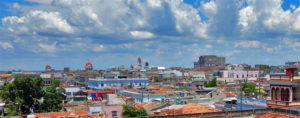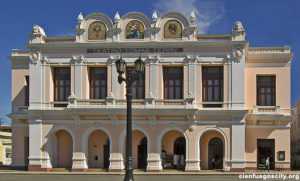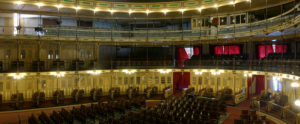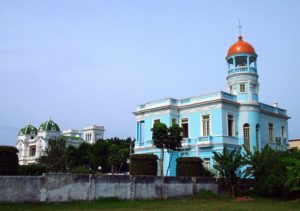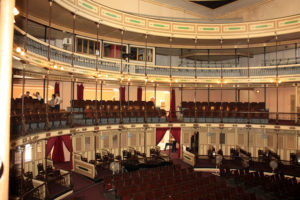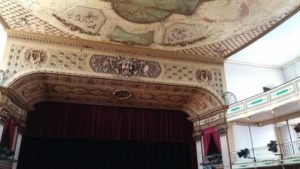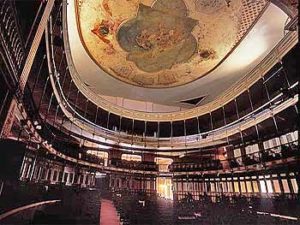CIENFUEGOS, CUBA AND THE HISTORY OF THE LUXURIOUS “TERRY THEATER”.
The Tomás Terry Theater is one of the most elegant eclectic buildings in the city of Cienfuegos.
The villa, which would be treasured over the years, is inaugurated under an indecent sign: the guatacazo, as we call the sermo vulgaris cubensis to the act of flattery.
Yes, because they call it Fernandina de Jagua. “Jagua” by the indocubano toponym that identified the zone. And “Fernandina” as a servile action before Ferdinand VII, the king felon, the monarch who had a horse’s face and hyena bowels. From 1829 it would be called Cienfuegos, in honor to a Captain General of the Island.
On April 22, 1819, a memory worthy of remembrance, it contemplates 46 Frenchmen planting improvised huts and canvas tents in a center of Cuba.
Captain of the founders of the infantry lieutenant colonel Juan Luis Lorenzo De Clouet, a lord of gallows and knife. Sovereign and tyrannical, he would keep the neighbors tightly guarded by means of corridors that would have informed him of all the intimate or public acts of the primitive cienfuegueros. Such would be his unpopularity that, in 1821, was the object of an attack, of which he was wounded in an arm.
On the other hand, it was not de Clouet precisely what one might call a friend of culture.
Thus, once the neighbors, convinced that the village required a place of instruction and recreation, commissioned three principals of the town to manage their aspiration to the principal.
The patriarch’s answer was one of those who make history because, without going about in a hurry, he told the emissaries that while he lived there, he would not allow “places of vagrancy and bad habits” to be established.
De Clouet did not suspect that Cienfuegos would be a city of exceptionally cultivated spirit, to the point that, when it had only 15,000 inhabitants, it would have no less than four theaters.
A unique character
The researcher Nara Araujo reminded us that in Cienfuegos of the 19th century a Venezuelan named Tomás Terry Adans earned beans – not always with good crafts – in modest stores on Bouyon and Dorticós streets.
Among other businesses, Terry buys ill slaves, sends them to cure, and then resells them, with the generous margin that gives him the “added value”: health.
In an area of difficult communications, he also deals advantageously in hauling goods for sugar factories. It is he who ensures that the cod and tasajo – imputrescible foods – arrive to their destination that will feed the negresses of the mills.
But it is not only by his economic activity that Terry arrives to be one of the richest men of the Island. His ascent to the cusp much has to do with the pragueta, that is, the marriage union with a wealthy consorte.
Terry will acquire sugar mills, but there are concerns that overflow the century in which he had to live: he is a herald of modernity to worry about what today we call construction of a public image. He knows of his plebeian and with the fasto and philanthropy must be built a nonexistent heraldic shield.
The theater
Thomas died in 1886 and it will be Emilio, the successor, who materializes the dreams of social elevation that makes him forget to the clan his origin of shopkeepers.
In order to assert himself, he bought Chenonceau, the dream castle that Henry II of France had given to the beautiful Duchess Diana of Poitiers, rival of the ungrateful Catherine de Medici.
But that is not enough. The apotheosis of the triumph of the race has to occur in the same initial place that had seen them drag their humble first existence.
In Paris the call is fought, to capture a dream in stone. The project of the military engineer Lino Sánchez Mármol – natural cuban of Santiago – is the winner, who will lead the constructive execution.
On the thirtieth night of February 12, 1890, the miracle was inaugurated, with opera, rhapsode Liszt, triumphal marches and the poet Diego Vicente Tejera reciting his famous poem, The hammock.
The Italian-style, horseshoe-designed theater has four floors of galleries, more than a thousand localities, ceiling with mythological allegories and a gold-embroidered curtain, costing 7,000 pesos.
So nobody will forget who the patrons were, at the entrance is placed a statue with the image of the founder of the clan. No doubt: the Terry have materialized their dream.
Let us congratulate ourselves on it. Yes, because of that scenario they have paraded from Sarah Bernhardt to Rosita Fornés, from Anna Pavlova to Alicia Alonso, from Caruso to Silvio Rodríguez, not forgetting Ernesto Lecuona, Jorge Negrete and Antonio Gades.
CIENFUEGOS, CUBA Y LA HISTORIA DEL LUJOSO “TEATRO TERRY”.
El teatro Tomás Terry, es uno de los más elegantes edificios eclécticos de la ciudad de Cienfuegos.
La villa —que sobradas glorias atesoraría con el paso de los años— se inaugura bajo indecoroso signo: el guatacazo, como llamamos en el sermo vulgaris cubensis al acto de adulación.
Sí, porque la bautizan como Fernandina de Jagua. “Jagua” por el topónimo indocubano que identificaba a la zona. Y “Fernandina” como acción servil ante Fernando VII, el rey felón, el monarca que tenía cara de caballo y entrañas de hiena. A partir de 1829 se llamaría Cienfuegos, en honor a un Capitán General de la Isla.
El 22 de abril de 1819 —fecha digna de recuerdo— contempla a 46 franceses plantando improvisadas cabañas y tiendas de lona en un paraje centrosureño de Cuba.
Capitanea a la hueste de fundadores el teniente coronel de infantería Juan Luis Lorenzo De Clouet, todo un señor de horca y cuchillo. Soberbio y tiránico, iba a mantener sobre los vecinos un férreo espionaje por medio de correveidiles que lo tendrían informado de todos los actos, íntimos o públicos, de los primitivos cienfuegueros. Sería tal su impopularidad que, en 1821, resultó objeto de un atentado, del cual salió herido en un brazo.
Por otra parte, no era De Clouet precisamente lo que se pudiera llamar un amigo de la cultura.
Así, una vez los vecinos, convencidos de que la villa requería de un lugar de instrucción y recreo, comisionaron a tres principales de la localidad para que gestionaran su aspiración ante el mandante.
La respuesta del patriarca fue de las que hacen historia pues, sin andarse con rodeos, les dijo a los emisarios que mientras él viviera allí, no permitiría que se estableciesen “sitios de vagancia y malas costumbres”.
No sospechaba De Clouet que Cienfuegos sería una ciudad de espíritu excepcionalmente cultivado, hasta el punto de que, cuando solo contaba con 15 mil habitantes, tendría nada menos que cuatro teatros.
Un personaje singular
Nos recordó la investigadora Nara Araújo que, en el Cienfuegos del siglo XIX, un venezolano llamado Tomás Terry Adans se ganaba los frijoles —no siempre con buenas artes— en unos modestos almacenes de las calles Bouyon y Dorticós.
Entre otros negocios, Terry compra esclavos enfermos, los manda a curar, y después los revende, con el generoso margen que le da el “valor añadido”: la salud.
En una zona de difíciles comunicaciones, también se ocupa ventajosamente en el acarreo de mercancías para las fábricas de azúcar. Es él quien asegura que llegue a su destino el bacalao y el tasajo —alimentos imputrescibles— que alimentarán a las negradas de los ingenios.
Mas no es solo por su actividad económica que llega Terry a ser uno de los hombres más ricos de la Isla. Su ascensión a la cúspide mucho tiene que ver con el braguetazo, o sea, la unión matrimonial con una consorte acaudalada.
Terry adquirirá ingenios azucareros, pero en él hay inquietudes que desbordan el siglo en que le tocó vivir: es un heraldo de la modernidad al preocuparse por lo que hoy llamamos construcción de una imagen pública. Sabe de su plebeyez y con el fasto y la filantropía debe construirse un inexistente escudo heráldico.
El teatro
Muere Tomás en 1886 y será Emilio, el sucesor, quien materialice los sueños de elevación social que le haga olvidar al clan su origen de tenderos.
Para afirmarse, compra Chenonceau, el castillo de ensueño que Enrique II de Francia le había regalado a la bellísima duquesa Diana de Poitiers, rival de la poco agraciada Catalina de Médicis.
Pero eso no basta. La apoteosis del triunfo de la estirpe tiene que ocurrir en el mismo paraje inicial que los viera arrastrar su humilde existencia primera.
En París se libra la convocatoria, para plasmar un sueño en piedra. Resulta premiado el proyecto del ingeniero militar Lino Sánchez Mármol —cubano natural de Santiago—, quien dirigirá la ejecución constructiva.
En la cienfueguera noche del 12 de febrero de 1890, se inaugura el milagro, con ópera, rapsodia de Liszt, marchas triunfales y el poeta Diego Vicente Tejera recitando su celebérrimo poema, La hamaca.
El teatro, de estilo italiano y diseñado según una herradura, cuenta con cuatro pisos de galerías, más de mil localidades, plafond con alegorías mitológicas y un telón de boca, bordado en oro, cuyo costo ha sido de 7 mil pesos.
Para que nadie olvide quiénes fueron los mecenas, a la entrada se coloca una estatua con la imagen del fundador del clan. No caben dudas: los Terry han materializado su sueño.
Felicitémonos de ello. Sí, pues por aquel escenario han desfilado desde Sarah Bernhardt hasta Rosita Fornés, desde Anna Pavlova hasta Alicia Alonso, desde Caruso hasta Silvio Rodríguez, sin olvidar a Ernesto Lecuona, Jorge Negrete y Antonio Gades.
Agencies/CubaAhora/Argelio Santiesteban/ Internet Photos/ Arnoldo Varona/ TheCubanHistory.com
THE CUBAN HISTORY, HOLLYWOOD.



